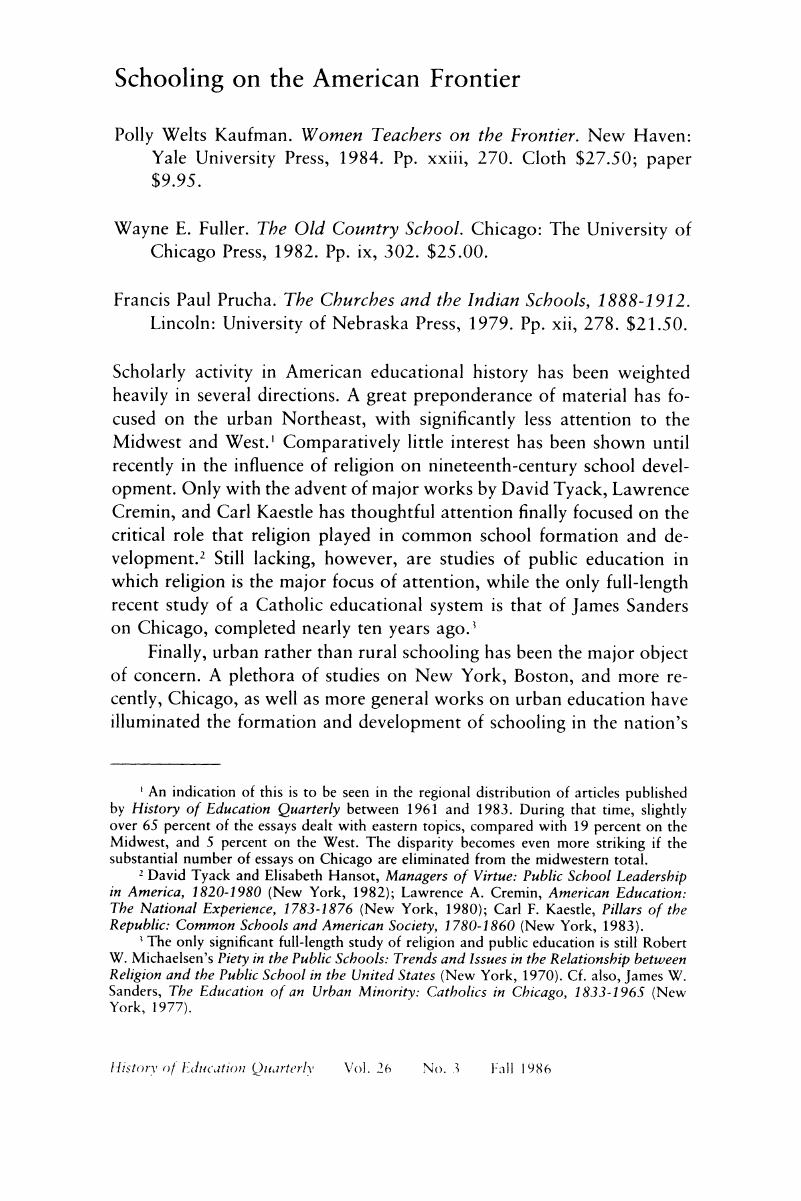Article contents
Schooling on the American Frontier
Published online by Cambridge University Press: 24 February 2017
Abstract

- Type
- Essay Reviews
- Information
- Copyright
- Copyright © 1986 by the History of Education Society
References
1. An indication of this is to be seen in the regional distribution of articles published by History of Education Quarterly between 1961 and 1983. During that time, slightly over 65 percent of the essays dealt with eastern topics, compared with 19 percent on the Midwest, and 5 percent on the West. The disparity becomes even more striking if the substantial number of essays on Chicago are eliminated from the midwestern total.Google Scholar
2. Tyack, David and Hansot, Elisabeth, Managers of Virtue: Public School Leadership in America, 1820–1980 (New York, 1982); Cremin, Lawrence A., American Education: The National Experience, 1783–1876 (New York, 1980); Kaestle, Carl F., Pillars of the Republic: Common Schools and American Society, 1780–1860 (New York, 1983).Google Scholar
3. The only significant full-length study of religion and public education is still Michaelsen's, Robert W. Piety in the Public Schools: Trends and Issues in the Relationship between Religion and the Public School in the United States (New York, 1970). Cf. also, Sanders, James W., The Education of an Urban Minority: Catholics in Chicago, 1833–1965 (New York, 1977).Google Scholar
4. Some examples are Lazerson, Marvin, Origins of the Urban School: Public Education in Massachusetts, 1870–1915 (Cambridge, Mass., 1971); Ravitch, Diane and Goodenow, Ronald K., eds., Educating an Urban People: The New York City Experience (New York, 1981); Kaestle, Carl F., The Evolution of an Urban School System: New York City, 1750–1850 (Cambridge, Mass., 1973); Harrick, Mary J., The Chicago Schools: A Social and Political History (Beverly Hills, Calif., 1971); and Wrigley, Julia, Class Politics and Public Schools: Chicago, 1900–1950 (New Brunswick, N.J., 1982).Google Scholar
5. Cremin, , American Education, 182–85.Google Scholar
6. Wade, Richard C., The Urban Frontier: The Rise of Western Cities, 1790–1830 (Cambridge, Mass., 1959).Google Scholar
7. Ravitch, Diane, The Great School Wars, New York City, 1805–1973: A History of the Public Schools as Battlefield of Social Change (New York, 1974); and Michael Perko, F., “The Building Up of Zion: Religion and Education in Nineteenth-Century Cincinnati,” Cincinnati Historical Society Bulletin 38 (Summer 1980): 97–114. While rural schools were dominantly Protestant in tone, there are also instances of German settlements in Ohio and Nebraska that co-opted common schools and turned them into Roman Catholic institutions.Google Scholar
8. Ravitch, , School Wars; Perko, , “Zion”; and idem, “By the Bowels of God's Mercy: Protestant and Catholic Responses to Educational Development in Cincinnati, 1830–1855,” Journal of the Midwest History of Education Society 11 (1983): 15–33.Google Scholar
- 1
- Cited by




